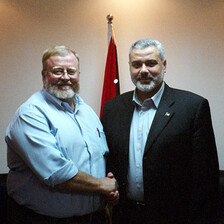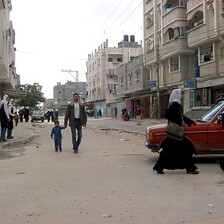
Shrapnel removed at Al Awda hospital in the Jebaliya Refugee Camp, Gaza, from a patient’s abdomen. The marking “Made in USA” and serial number 9633 are clearly visible on the twisted metal. (Scott Kennedy)
As I entered the powerful new museum of the Holocaust at Yad Vashem in Jerusalem in early November, I was confronted by these words: “A country should be judged not only by what it does, but also by what it tolerates.”
Kurt Tucholsky, WW1 veteran and pacifist, journalist and social critic whose books were burned by the same Nazi regime that stripped him of his citizenship, wrote the statement after Germany adopted the anti-Semitic Nuremberg laws. His sobering contention was brought vividly to mind during my visit to Gaza, Palestine ten days later. Gaza is a 140 square mile area packed with 1.5 million people. In Gaza I observed not only the consequence of our nation’s toleration of certain policies and practices. I also saw how language is used to obscure and distance us from the evil that we tolerate.
Barely two hours after entering Gaza on November 18th, I watched an Israeli Defense Forces (IDF) Apache Helicopter hover eerily above the densely populated Bedouin town of Beit Lahiya in the Northwestern Gaza Strip, population 40,000. Bursts of cannon fire from the helicopter reverberated across the Northern Gaza, rattling the fourth story windows of the Al Awda Hospital in nearby Beit Hanoun as I squinted in the bright sunlight to make out the helicopter. A cloud of smoke briefly obscured the helicopter against the bright blue sky and then quickly cleared. A few moments later, another round was fired into the heavily populated residential area below.
Back at my hotel later that afternoon, I spoke with William Dienst, an American family and emergency physician in the West Bank and Gaza for the fourth time, who had rushed to nearby Kamal Adwan Hospital with Palestine Medical Relief Society colleagues where wounded were received from the helicopter attack. Still shaken by the experience, Dr. Dienst described witnessing the lifeless body of Thaer Al Masri, a 16 year old boy killed by a large caliber gunshot wound through the neck. He was also involved in the hospital trauma team’s successful resuscitation of a 20 year old male suffering from a large caliber gunshot wound to the left chest. Unfortunately, this young man died later due to ongoing internal bleeding.

The major bridge connecting Beit Hanoun to the primary border crossing between Gaza and Israel, damaged by Israeli rockets. (Scott Kennedy)
Dr. Dienst commented wryly that the helicopter attack would no doubt be featured in the evening news as another “clash” between Israeli and Palestinian forces in the Gaza Strip. “How can it be a ‘clash,’” he asked, “when the forces are so drastically unequal and the outcome so predictable?” I later read news accounts about heavy shooting by helicopters targeting Beit Lahiya that day and “armed clashes” between “militants” and the IDF. The report said there was one fatality — Thaer El Masri aged 16 years. Sure enough, that night the ticker running across the bottom of the international news television screen read, “Five killed in clashes in West Bank and Gaza.”
Five Palestinians killed, that is. Like clockwork. Or shooting fish in a barrel.
I thought again of Tucholsky’s quote. The people were killed with advanced military weaponry in many cases, such as the Apache helicopter that killed two young men in Beit Lahiya while I watched, was developed in the USA, manufactured in the USA, provided to Israel by the USA and paid for in most cases by US tax payers. For those who may be interested in knowing the impact that our country has on people overseas, language commonly used to describe can make it difficult to find out and masks what is truly going on. In this case, “clashes” reinforces images of two somewhat equal parties engaged in conflict. In fact the might of one of the most powerful militaries in the world is arrayed against an essentially defenseless civilian population in Gaza.
Certainly Palestinian violence has targeted and killed Israeli civilians. Perhaps equally reprehensible, Palestinian paramilitary groups, firing thousands of home made Qassam rockets (HMRs) over the separation barrier surrounding Gaza, spread terror in Israeli communities such as Sderot, even though these rockets are crudely built and poorly aimed and often hit Palestinian areas or strike harmlessly in the nearby desert. Even during direct Israeli military occupation of Gaza, before the “disengagement” in August of 2005, Israeli troops could not stop the firing of HMRs from Gaza. The Palestinian Authority and its security forces are much more poorly equipped to stop them. The dismantling of Jewish settlements in Gaza and pullout of Israeli troops actually was intended to give the Israeli military a freer hand in attacking those firing the rockets, with little effect.
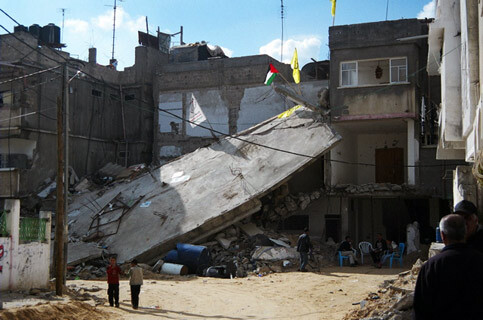
A home demolished in Jebaliya Refugee Camp, Gaza. Palestinian and Fateh movement flags raised above the rubble. (Scott Kennedy)
The targeting and killing of Israeli civilians is often broadcast in such a way to reinforce the impression that Palestinian violence constitutes a mortal threat to Israel’s continued existence. As of July 5, 840 Palestinian rockets were fired towards Israel from within Gaza. Meanwhile, during the same period, Israel fired 8,300 shells and rockets into Gaza, nearly ten times the number of Palestinian rockets.
In the past five years, Palestinian HMRs and mortars have killed ten Israelis in Israel (including several Arab citizens of Israel) and seven Israelis in illegal Jewish settlements within Gaza, for a total of 17 deaths. In slightly more than four months, on the other hand, Israeli forces have killed 400 Palestinians in Gaza. More than 40 percent of those killed were civilians and more than 60 of those killed were children. We are told that Palestinians target civilians and the Israelis only kill civilians by accident. This may sound reassuring, but the Israelis killed more civilians in one “accident” ten days before my visit, than the Palestinians have killed with all their Qassam rockets in more than half a decade.
In June 2006 fighters from Hamas captured an Israeli soldier just across the border from Gaza. This soldier’s capture plus the continuing “threat” of the HMRs provoked massive Israeli military retaliation. Israeli forces launched a series of “incursions,” in fact a re-invasion and occupation of Gaza. They called the invasion “Summer Rains” and said its purpose was to free the captured Israeli soldier and to catch or kill those responsible. The Israeli military action was a typically calculated overreaction to any act of violence by Palestinians.
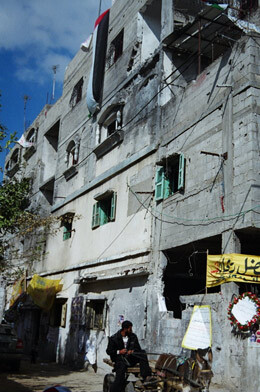
An apartment building shelled by Israeli forces on 8 November 2006, killing 19 people including many members of one family. (Scott Kennedy)
At the Beit Hanoun apartment building, smoke and fire had blackened the concrete around windows and several gaping holes through which I could see collapsed walls and ceilings. I met a Palestine Red Crescent ambulance worker across the street from the building who had helped transport the casualties of the shelling to the hospital. He presented several young girls who survived the shelling. Their heads, necks and exposed arms showed cuts and bruises from shrapnel and flying concrete. Many members of their family had been killed. My guide warned against entering the building because the anger against Americans in the building and neighborhood was running so high.
Later, at Al Awda (“the Return”) Hospital, doctors showed me photos of the Palestinian victims of Operations Summer Rains and Autumn Clouds and shrapnel removed from their bodies. Several pieces of twisted metal clearly bore the marking “made in the USA” and legible serial numbers. Just a few days prior to my arrival in Gaza, the US vetoed a UN Resolution condemning the bombing in Beit Hanoun. Ironically, the director of the hospital was telling me how much more difficult it has become to persuade Palestinians to distinguish between the American people and our government when suddenly shooting from the helicopter, described above, interrupted our conversation. It is no wonder that the Palestinian people are outraged, he explained, at American backing for Israel’s ongoing aggression in Gaza.
The fighting in and around Gaza is sometimes seen as a “war” between Israel and Palestine. But it is not a war. What’s going on in Gaza is an American financed slaughter.
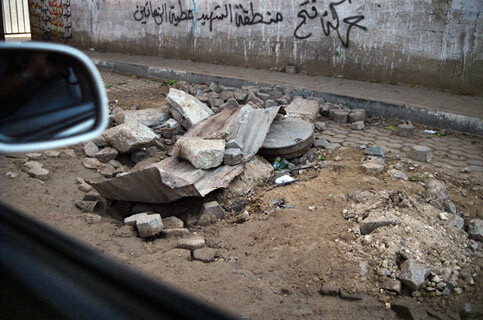
The sewer system was damaged by Israeli tanks in Beit Hanoun. (Scott Kennedy)
In my two days visiting Beit Hanoun, Beit Lahiya, Jebaliya Camp, Gaza City and Rafah, I saw plenty of evidence of the widespread devastation left by Israeli forces. There were dozens of sites, either single plots or entire city blocks, where houses were crumpled and rendered uninhabitable. I was appalled by the widespread destruction of the public infrastructure. During the 1950s Ariel Sharon had cut a grid of wide roadways through the refugee camps to provide Israeli troops ready deployment in the population centers. Still I saw that the corners of buildings at many intersections were slumping, apparently inadvertently wrecked as tanks turned the corners during this summer’s invasion. Power and telephone polls had been snapped off. Much of the curbing and medians were chewed up by heavy treads. Many streets evinced damage by Israeli tanks and other vehicles. Sewage pipes were damaged and effluent was pooling in some streets. Broken-back bridges sagged on major streets and highways.
In Rafah, we saw a barren expanse of concrete heaps and dirt mounds along the three-meter high metal and concrete barrier marking the Egyptian border. Israeli forces demolished more than 700 homes in the the Tel al Sultan residential zone of Rafah alone. In all, an estimated 2,000-3,000 Palestinian homes have been destroyed to create the Philadelphi corridor, making tends of thousands of Palestinians homeless. The great wasteland covered many acres of what used to be housing. Dr. Dienst and I asked to be taken to the location where American peace activist Rachel Corrie was crushed and killed by an Israeli bulldozer in March of 2003. The local police had some difficulty identifying the site. The streets and alleyways and block after block of residential buildings were all gone and they could hardly recognize the site after recent rains. Such ruin is justified as a necessary part of Israel’s “war on terror.” The heavily armed security detail asked to have a photo taken with us at the site of Corrie’s death. They don’t want Rachel Corrie, or themselves, to be forgotten.
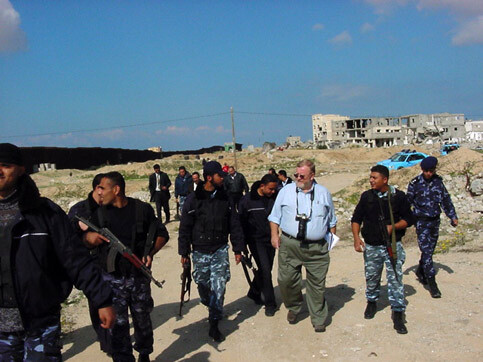
Palestinian police and a Palestine Authority security detail accompany Scott Kennedy in the Tel al Sultan neighborhood near the wall with Egypt on Gaza Strip’s southernmost border. Israeli forces have destroyed 700 homes in the Tel al Sultan secton of the Philadelphi Corridor, a 100-200 meter wide swath along the Egyptian border with a metal and concrete wall that divides the city of Rafah in half. (Bill Dienst)
In other towns in Gaza, I was impressed to see municipal workers repairing power and telephone lines and cleaning streets. I had read that public employees had not been paid for more than eight months. Having served in local government during recovery from a major earthquake in my home town, I was left shaking my head at the thought of how very long it would take to repair the infrastructure of Gaza and at what great price. How will Gaza ever recover?
At one point during the summer, Israeli over flights created round-the-clock sonic booms and air strikes destroyed Gaza’s only power station. This single act reduced available electricity to Gaza by more than 65 percent and crippled the water and sewer treatment facilities. Israeli Prime Minister Ehud Olmert reportedly commented to his cabinet, “Nobody dies from not having electricity” and “no one in Gaza should sleep.” Relief and human rights organizations began to raise a cry about the onset of malnutrition and hunger and the impact of acute stress and trauma, especially on children. An adviser to Olmert responded, “The idea is to put the Palestinians on a diet, but not to make them die of hunger.” People in Gaza clearly understand that their suffering is not accidental or “collateral damage” caused by IDF operations to stamp out terrorism. The deprivation, suffering and death of the civilian population is an intentional strategy, imposed as conscious policy.
Such comments by Israel’s leaders are outrageous, if not obscene. Yet they are digested without comment by mainstream newspaper editorial writers in the U.S. Even the most progressive of anti-war American elected officials gladly fund Israel’s military underwriting such practices. The Bush Administration raises only the most muted objections or exercises its veto to stifle international objections. Our nation may not be directly involved in inflicting punishment on families, neighborhoods and entire cities in Gaza, but the collective punishment we fund is illegal according to international humanitarian law and the Geneva Conventions, to which both Israel and the US are signatories.
So too, when the Israelis rounded up and handcuffed more than 4,000 men from 16 to 45 years of age from Beit Hanoun, held and interrogated them in a makeshift detention on the beach by Beit Lahiya, Israel counted on our nation looking the other way.
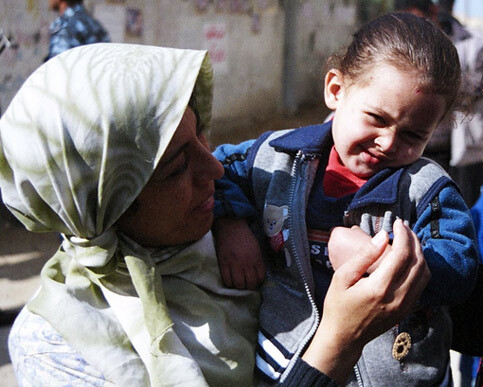
This young girl survived the Beit Hanoun shelling, though her forehead and neck had shrapnel cuts and brusiing. (Scott Kennedy)
According to US and Israeli spokespersons, the civilian population of Gaza will be deprived of food and water and basic services to force a change in the Palestinian government from Hamas to one more amenable to American and Israeli wishes. Israel’s gratuitous destruction of Gaza’s public infrastructure is all fair game. Civil war will be fomented among the Palestinians as an explicit means of achieving the US goal of bringing down Hamas. The US public is comforted by the reassuring notion that the “clashes” and “accidents” are inevitable outcomes of Israel fighting a war for its very survival. But is not part of Tucholsky’s point that nations should be judged by the consequences of their actions, not only by their intentions?
When we talked that first afternoon in Gaza, Dr. Dienst described his last several nights there. Soon after 11:00 p.m., he explained, Israeli helicopters slide down the Mediterranean coast and position themselves above one of the teeming refugee camps or crowded towns of Gaza. From the safety of their perch in the sky, the helicopters pummel Palestinian houses, reducing concrete block homes up to four or five stories high to a pile of rubble. The homes typically house several generations and a dozen or more members of a Palestinian family. Israeli artillery may be employed from just outside the narrow breadth of Gaza to do the job. At other times, the Israelis send in ground forces with tanks and Caterpillar D9 armored bulldozers. The attack may target a “wanted” person. But demolition of houses is also a favored form of collective “punishment” imposed on the extended families of those Palestinians accused of being “terrorists,” or “militants,” depending on your point of view. By what right is such a heavy penalty inflicted on their families and neighbors.
“Just step out on your balcony,” Dienst encouraged me. “You can watch the fireworks from there.”
That night, I left the window in my hotel room overlooking the beach open so that any shooting would wake me up. I slept the night undisturbed, however, and asked at breakfast what had happened. I learned that a remarkable act of nonviolent civilian resistance had deterred the nightly Israeli assault. In order to reduce civilian casualties, the Israelis have made phone calls to warn residents that their home will soon be destroyed. Sometimes people are told the demolition will occur the next day. Other times the family has thirty minutes or less to remove items of value from their home before it is flattened. All the inhabitants may flee immediately, not knowing when a rocket might strike. There are reports of families that received the warning call and then nothing happens. They are left uncertain if they are victims of a malicious prank or if it is in fact safe to return to their home.

Homes demolished by Israeli forces in Rafah, southernmost Gaza. (Scott Kennedy)
The night of my visit to Gaza, hundreds of unarmed Palestinians thwarted the IDF’s announced plans to destroy a residence in Jebaliya, the world’s largest refugee camp with 100,000 residents packed into a little more than half a square mile. Several dozen people swarmed onto the roof while hundreds of women surrounded the targeted building. When Israeli helicopters arrived and surveyed the scene, they decided against an attack. A slew of civilian casualties would not look so good following international outrage about the Beit Hanoun massacre two weeks earlier. According to the Israeli Ministry of Foreign Affairs in Jerusalem, “the IDF counter terrorist operation had to be canceled due to the proximity of the civilians — demonstrating vividly that the Palestinians know that Israel values their lives more than the Palestinian terrorists do.” This statement, while it plays well in the American press, would sound odd to the Palestinian residents of Gaza that has suffered more than 150 civilian fatalities and seen thousands made homeless and tens of thousands traumatized by Israeli forces in the preceding four months.
I met some of those made homeless when I visited the remains of the 800-year-old al Nasr Mosque in Beit Hanoun. Several hundred unarmed women had surrounded the mosque and successfully prevented capture of up to 15 targeted men being sought by an Israeli ground force who had sought refuge inside. According to IDF officials, the militants had fired at Israeli troops from inside the mosque. The crowd surged towards the Israeli soldiers who fired and killed two women and wounded dozens more. The Israelis then retreated and the men escaped.
But the victory was short-lived. Israeli forces returned and demolished the mosque, leaving only the minaret in tact. They also demolished several nearby houses where military authorities said weapons were found. Forty people were made homeless, including several women who sat speechless on the rubble of their homes or wept inconsolably staring at the ground as I approached the scene.

Dr. William Dienst (third from left) and Scott Kennedy (fifth from left) accompanied by Palestinian security detail on the site where Rachel Corrie was killed, Rafah, Gaza Strip.
I cannot imagine the circumstances in which people of the United States would accept destruction of homes because a family member was accused (not even convicted) of committing a crime or planning to commit a crime or alleged crimes were being committed in the neighborhood, about which a person may not even be aware or over which have any control. I expect authorities would find quite a few weapons in US neighborhoods if American homes were threatened with widespread and arbitrary demolition by a foreign power.
Acts of unarmed civilian resistance by Palestinians, such as surrounding the mosque and defending the home in Gaza, were just two of many examples of imaginative and courageous active nonviolence about which I saw. I visited several promising community projects in Khan Younis and Rafah: an employment center for female victims of domestic violence, cultural centers, health clinics and schools. People continue to nurture a civil society in Palestinian areas, what Gandhi would call “constructive works,” despite the formidable obstacles they face and the repeated disruption of their activities. So the range of Palestinian nonviolence stretched from daily constructive work to build and strengthen civil society, to persistent advocacy for human rights and democracy, to dramatic acts of popular resistance.

During dry periods, traffic detours through a shallow river bed past a major bridge destroyed by Israeli forces, on the main North-South road running the length of the Gaza Strip, connecting Gaza City to Khan Younis. (Scott Kennedy)
Still, I realized that the decision of unarmed civilians in Gaza to defend a threatened home is much as anything an act of despair in the face of indifference by the United States and the world to what is happening in Gaza. So too the firing of rockets continues for the media and psychological impact as much as any actual damage done. The difference is, I think, that the futile military gestures further delegitimized the Palestinians’ standing in world opinion and undercut Israeli peace forces, while the nonviolent acts of resistance strengthen the Palestinians’ legal and moral cause and strengthen allies in Israel and abroad. Unfortunately, even though word of this bold act of popular resistance’s immediate success spread like wildfire through Gaza and the international media, very little is said in the US media about either the ongoing overwhelming military assault on the civilian population of Gaza or the brave acts of popular defiance undertaken by its civilian population.
Palestinians were troubled when a prominent international human rights organization declared that such use of “human shields” to protect “suspected militants’ homes” was a war crime. I wondered how civilian homes, even those belonging to an extended family of a person targeted for assassination or those accused of crimes, had become legitimate military targets in the eyes of the world?
Why would an international human rights organization condemn the desperate act of unarmed civilians attempting to stop the wanton destruction of their homes and families?
The Israeli military does its deadly work in Gaza with little or no interference from other nations. For their part, the Palestinians will use tactics such as swarming threatened targets with unarmed civilians again, if only because they have no military force capable of stopping the Israeli juggernaut. So I wasn’t surprised when a second house was saved from demolition by similar mass civilian action a few days later.
These tactics confront the Israelis, on the other hand, with a very tough choice. They must either risk injury or death of its soldiers by sending in ground forces to effect the demolitions, or use artillery or rockets without warning or despite the presence of many civilians, likely resulting in far more civilian casualties. Few observers expect that the Israelis are willing to foreswear their widespread practice of collective punishment and home demolitions. The growing nonviolent action may well have contributed to Israel’s recent decision to enter into a cease-fire in Gaza. Hopefully negotiations will get back on track as the Israeli-Palestinian conflict, short of genocide, does not lend itself to a military solution.
Those few people in the US who have given it any thought at all, seem to think that Israel has withdrawn from Gaza. “Clashes” are portrayed as battles between two warring parties. The reality is that Israel continues to exercise systematic and comprehensive control of nearly every aspect of Palestinian life in Gaza. A Palestinian college professor whom I met in Gaza, for example, has been married for a decade to a South African woman. His wife can only join him in Gaza on a three-month tourist visa like that I receive when visiting. The Israelis won’t let his wife live in Gaza, more than a year after their “disengagement” from Gaza. Of course, he is welcome to join the ranks of Palestinians who finally give up and leave, permanently forfeiting the possibility of returning to their homes and families.
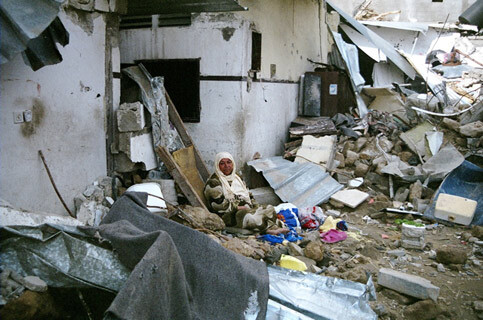
A woman sits upon the rubble of her home destroyed next to the al-Nasr Mosque in Jebaliya Refugee Camp, Gaza Strip. Israeli officials said weapons were found in the three homes destroyed along with the 800 year old mosque. (Scott Kennedy)
Preventing a married couple from living together is a small, perhaps banal, example of Israel’s continuing domination of Gaza. The IDF also controls the air over Gaza, all of its borders with Israel and Egypt, and the Mediterranean coast. Commercial crossings from Gaza into Israel were closed about 20 percent of the time before official “disengagement.” Since August 2005 the commercial border crossings have been closed 60 percent of the time, devastating commerce. Fishermen cannot sail more than a few hundred yards from the shore. Israel controls most water and all electricity in the Palestinian area. The Israeli military enters Gaza at will to demolish homes and other buildings, to impose curfews, enforce economic sanctions, and to assassinate those they consider a threat. All of these actions converge in creating a severe humanitarian crisis in Gaza, and have, if anything, only justified in the eyes of many Palestinians continuing rockets attacks on Israel.
As I was driven back to the Erez border crossing to exit Gaza, a white shape hanging in the blue sky over the northernmost border with Israel caught my eye. I remarked that at home, such balloons advertise a car sale or boost a furniture store’s perennial going out of business sale. In Gaza, this and several other pilot-less lighter-than-air balloons surveil the activities of Palestinians below and provide direction for military assaults by Israeli forces into the Palestinian territories inside their separation barrier.
For nearly six decades of belligerent military occupation of Gaza, the Israeli military has assaulted, degraded and destroyed the private property and public infrastructure of Gaza with impunity. These practices are routine despite the so-called “disengagement” of Israel from Gaza in August of 2005. The Gazans have no effective means of self-defense. Palestinian security forces have no weaponry capable of counteracting Israel’s tanks, artillery, aircraft and overwhelming force of men under arms. Their facilities have also been flattened, vehicles destroyed and forces decimated by ongoing Israeli offensives. Palestinian authorities are even less capable of stopping occasional attacks aimed at Israel. Meanwhile, the international community does little or nothing to stop ongoing attacks on Gaza. It’s almost impossible to get into Gaza to even see what is going on. When the UN finally takes action, the US wields its veto power to shield Israel from any sanctions or its economic and diplomatic might to minimize international pressure.
When looking at the ruins of al Nasr Mosque, several Palestinians whose homes had been bulldozed beseeched me to tell others “in America” what had happened to them. They demonstrated the widespread and seemingly irrepressible faith among Palestinians that if Americans only knew what was going on in Gaza, then surely we would stop sending the weapons that Israel uses to control and attack the civilian Palestinian population.
I didn’t have the heart — or the courage — to explain that most Americans simply don’t care to know what is done with our money or what is made possible by our nation’s diplomatic and economic support. Or, if they do know, they don’t care enough to do anything about what is going on in places like Gaza. Many otherwise thoughtful people in the United States, people with a demonstrated commitment to human rights and social justice, defend whatever actions Israel may take, regardless of international law and despite devastating consequences for a defenseless civilian population such as the Palestinians in Gaza. Glib slogans are offered in defense of actions that they would not support or want to pay for anywhere else. This degree of indifference is constructed through a concerted effort to prevent the U.S. public from really knowing what is going on.
Whatever the case, the United States sends $10 million a day to Israel. Our support and tolerance of what goes on there flows essentially unchallenged through Congress and unnoticed by the public.
Kurt Tucholsky says a country “should be judged … by what it tolerates.” If that be true, in light of what I saw happening in Gaza, the United States and all of us who live, vote or pay taxes here, have a lot to answer for.
Scott Kennedy coordinates the Middle East Program of the Resource Center for Nonviolence in Santa Cruz, California. He was elected to three terms on the Santa Cruz City Council and served twice as mayor. Kennedy was elected national chairman of the Fellowship of Reconciliation and founded and chaired the FOR’s Middle East Task Force. He has traveled to the Mid East four dozen times since 1968 and most recently in November 2006 when he colead a delegation for the Interfaith Peace-Builders. Contact: kenncruz@pacbell.net
Related Links
